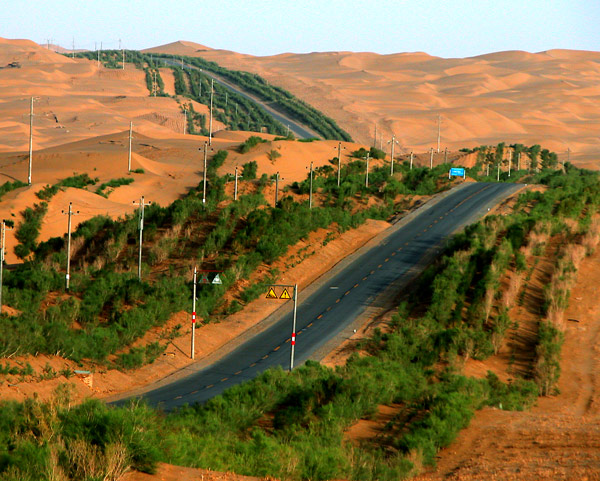

The 562-kilometer road connecting Urumqi and Hotan, which once was plagued by problems caused by the sand, now has desert plants as protection. Provided to China Daily
The spread of sand in Xinjiang stops, and a major road to Urumqi is saved
For 2,000 years, people have battled the relentless wind and sand of the unforgiving Taklimakan Desert.
Ancient civilizations along the Silk Road were swept aside, leaving traces of their existence only in the remains of temples and frescos.
Qira county in the southwest of the Xinjiang Uygur autonomous region is one of the most severely hit regions.
Without scientific methods to combat desertification, the march of the sands of time would have continued.
But scientists have found an oasis of triumph after three decades.
The Qira research station of the Chinese Academy of Sciences was established in 1983. With the help of the scientists from the station, a transitional zone was established, and gradually the sand was pushed back more than 5 kilometers.
Jappar Mashrap, 49, lives in Qira and has witnessed the change and benefited from the work of the scientists.
Mashrap's endangered home was on the fringe of the desert and the family had to move in the late 1960s as the sand crept closer.
But thanks to the work of the scientists, the desert's march was stopped and Mashrap has a home again.
"Now on Children's Day, people often take their children to the amusement park, but things were quite different when I was a boy," Mashrap said.
"In those days, to celebrate festivals, my parents had to take me a long way to find grass where we could play.''
The sand also threatened a major road running through on the north-south axis of the Taklimakan Desert.
The 562-kilometer road, completed in 1995, shortens the route between Urumqi and Hotan by 500 km. But it had been plagued by problems caused by the sand.
Xu Xinwen, director of the station, and his team devoted much of their efforts to securing the road.
"Sometimes the sand on the road piles up a few meters high," Xu said. Various methods were tried, including fencing and barriers, but each had a drawback.
"The most effective barrier for sand is greening," Xu said.
Pressure mounts over arable land resources
2012-12-26Keep a red line for arable land
2012-03-05President Hu stresses arable land protection
2011-08-24Copyright ©1999-2018
Chinanews.com. All rights reserved.
Reproduction in whole or in part without permission is prohibited.